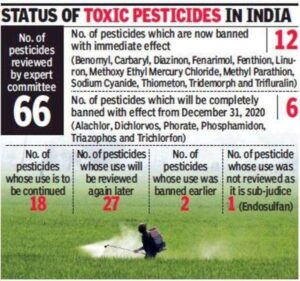Topics
- UNESCO endorses Banning Smartphones from Schools
- 530 districts reported free of Manual Scavenging
- EVALUATION OF WIND ENERGY
- PESTICIDE BAN
- HEMATENE
- Kargil Vijay Diwas
UNESCO endorses Banning Smartphones from Schools
News:
In its latest release, the Global Education Monitoring (GEM) Report 2023 by UNESCO raised concerns regarding the adverse effects of excessive screen time on the well-being and academic performance of children.
Basics of UNESCO:
| Full form | United Nations Educational, Scientific and Cultural Organization |
| Type | United Nations specialized agency |
| Founded | 16 November 1945 |
| Headquarters | Paris, France |
| Director-General | Audrey Azoulay |
| Mission | To promote world peace and security through international cooperation in education, arts, sciences and culture |
| Members | 190 members |
| Programme areas | · Education,
· natural sciences, · social/human sciences, · culture and communication/information |
| Languages | Official languages: Arabic, Chinese, English, French, Russian, Spanish
Working languages: English, French
|
Global Education Monitoring Report 2023

Overview
- The Global Education Monitoring (GEM) Report, established in 2002, operates as an independent editorial report under the auspices of UNESCO.
- It was mandated by 160 governments during the 2015 World Education Forum to monitor and report on progress toward achieving Education Sustainable Development Goal 4.0 (SDG 4.0).
- The report serves as a comprehensive assessment of critical global education issues and challenges while providing evidence-based insights and policy recommendations to enhance educational systems and outcomes.
Concerns Raised in the Report
- Ills of Digital Learning
- The GEM Report highlights that the benefits of digital learning diminish when technology is excessively utilized without qualified teachers’ involvement.
- The report stresses the importance of striking a balance between technology use and traditional teaching methods to ensure effective learning outcomes.
- Equitable Learning
- Exclusively remote instruction poses challenges to equitable learning, particularly impacting vulnerable students, especially in rural areas.
- The report sheds light on the emerging inequities in access to education caused by the reliance on remote learning methods.
- Evidence-Based Approach
- The report emphasizes the necessity for sound, impartial evidence on the impact of technology in education.
- It raises concerns about the biases in existing evidence, primarily originating from technology companies, and calls for more objective research to inform educational policies.
- Long-Term Costs and Sustainability
- Countries are urged to consider the long-term costs and sustainability of digital learning and connectivity initiatives.
- While Edtech market expansion is significant, the report warns against neglecting the unmet basic education needs and ensuring the financial feasibility of technological interventions.
- Threats Posed by AI
- The growing influence of generative AI and technology calls for the development of digital literacy and critical thinking skills.
- The report highlights the importance of preparing students to navigate the challenges and opportunities brought by AI advancements.
- Protecting Children’s Rights
- During the pandemic, various online education initiatives risked infringing on children’s rights.
- The report advocates for safeguarding children’s rights while implementing digital learning solutions and promoting a safe and secure online environment.
Key Endorsements: Banning Smartphones in Schools
- Based on research indicating improved academic performance, particularly among low-performing students, the GEM Report endorses the idea of banning smartphones in schools.
- This endorsement is conditional on the premise that technology integration does not yield significant learning improvements or negatively impacts student well-being.
Question: Analyze the long-term costs and sustainability, considerations of digital learning and its potential impact on basic education needs.’
530 districts reported free of Manual Scavenging

Context
- Manual scavenging, a dehumanizing practice of removing human excreta by hand from sewers or septic tanks, persists in India despite being banned under the Prohibition of Employment as Manual Scavengers and their Rehabilitation Act, 2013 (PEMSR).
- The Social Justice Ministry reported that while 530 districts have declared themselves manual scavenging-free, there are still significant challenges in eliminating the practice.
Challenges in Eradicating Manual Scavenging
- Low Awareness and Marginalization
- Exploitation of marginalized communities due to lack of awareness about their rights.
- Vulnerability to manual scavenging due to societal discrimination.
- Weak Enforcement
- Insufficient implementation and enforcement of the PEMS Act.
- Exploitation of unskilled laborers contributing to the persistence of the practice.
- High Cost of Automation
- Municipal authorities deterred from adopting automated cleaning methods due to high costs.
- Cheap Availability of Unskilled Labor
- Contractors illegally employ unskilled laborers at lower wages, perpetuating the practice.
- Caste Dynamics
- Existing caste hierarchy reinforces manual scavenging, with lower castes disproportionately affected.

Various Policy Initiatives
- Prohibition of Employment as Manual Scavengers and their Rehabilitation (Amendment) Bill, 2020
- Proposal to mechanize sewer cleaning and provide on-site protection and compensation for sewer-related deaths.
- Prohibition of Employment as Manual Scavengers and their Rehabilitation Act, 2013
- Outlaws all forms of manual excrement cleaning in insanitary latrines, open drains, or pits.
- Rashtriya Garima Abhiyan
- “Maila Mukti Yatra” initiated to eradicate manual scavenging nationwide, starting from Bhopal.
- Prevention of Atrocities Act
- Provides protection for sanitation workers, who often belong to the Scheduled Caste.
- Compensation
- PEMSR Act and Supreme Court’s decision mandate Rs 10 lakh compensation for victims’ families.
- National Commission for Safai Karamcharis (NCSK)
- Investigates the conditions of waste collectors and provides recommendations to the government.
- Proper Distinction
- Recognizing the difference between sanitation work and manual scavenging.
- Enumeration of Sanitization Workers
- Conducting enumeration in 500 AMRUT cities as part of NAMASTE to track progress.
Solutions for a Manual Scavenging-Free India
- Regular Surveys and Social Audits
– Public and local authorities should conduct regular surveys and social audits to identify manual scavengers.
- Capacity Building and Alternate Livelihoods
– Proper identification and capacity building of manual scavengers for alternative sources of livelihood.
- Awareness and Legal Protection
– Creating awareness among affected communities about their legal protection and rights.
Conclusion
Despite significant efforts and policy initiatives, manual scavenging remains a persistent issue in India. To achieve a manual scavenging-free society, it is crucial to address the challenges, enforce existing laws, and work towards uplifting marginalized communities.
Questions
- How does manual scavenging perpetuate the cycle of caste-based discrimination in India? Suggest measures to break this cycle.
- Compare and contrast manual scavenging with modern sanitation practices and technologies. What steps can be taken to transition from manual scavenging to mechanized sanitation?
EVALUATION OF WIND ENERGY

Context
The Standing Committee on Energy, during its parliamentary sitting on July 20, 2023, considered and adopted the report titled “Evaluation of Wind Energy in India.”
The report, presented as the Twenty-Seventh Report, was laid before the Lok Sabha on August 2, 2022, and on the same day, it was also presented to the Rajya Sabha.
The Ministry of New and Renewable Energy (MNRE) revised the ‘Policy for Repowering of the Wind Power Projects,’ which was initially issued on August 5, 2016. Stakeholders’ comments on the revised policy were sought on October 17, 2022.
- Untapped Wind Potential
The Committee’s observations revealed that only a small fraction of India’s vast wind potential has been effectively utilized. The slow capacity addition is attributed to two key factors:
- the transition from feed-in-tariff to competitive bidding for tariff determination, and
- aggressive bidding practices by developers.
- Repowering of Old Turbines
- India’s wind energy potential is concentrated in eight states, namely Andhra Pradesh, Gujarat, Karnataka, and Madhya Pradesh, among others.
- The Committee recommended two crucial steps to enhance efficiency:
- replacing old and less efficient turbines with advanced models
- formulating a policy for repowering old turbines and providing guidelines for recycling the replaced equipment.
- Addressing Defaulting Developers
- To ensure the smooth functioning of wind power projects, the Committee suggested introducing provisions for imposing heavy penalties on developers who back out unilaterally.
- Additionally, persistent defaulters should be blacklisted to deter non-compliance with project commitments.
- Promotion of Wind-Solar Hybrid Projects
- Recognizing the complementary nature of wind and solar energy, with solar being harnessed during the day and wind during the night, the Committee proposed the promotion of wind-solar hybrid projects.
- This initiative aims to harness over 50 GW of combined potential from both sources.
- REFER IMAGE-A AT THE BOTTOM
- Non-Payment by Distribution Companies
The Committee identified non-payment of dues by distribution companies (discoms) as one of the reasons contributing to Non-Performing Assets (NPAs) in the wind energy sector.
- Ensuring Renewable Purchase Obligation (RPO) Compliance
- Out of all states, only Himachal Pradesh, Karnataka, Andhra Pradesh, and Tamil Nadu have fulfilled the RPO target of 19% set as per the National RPO trajectory for 2020-21.
- The Committee recommended strict enforcement of RPO compliance by all states and the implementation of penalties against entities failing to meet their obligations.
- Exploring Offshore Wind Power Potential
- The Committee highlighted the vast potential of offshore wind energy, estimated to be around 70 GW off the coast of Gujarat and Tamil Nadu.
- To fully utilize this resource, the Committee suggested exploring offshore wind potential in different coastal areas of India.
IMAGE-A

Conclusion
The Standing Committee’s evaluation report sheds light on critical aspects of India’s wind energy sector. By implementing the recommended measures, the country can tap into its vast wind potential, increase efficiency, and achieve greater integration of renewable energy sources for a sustainable future.
PESTICIDE BAN

Context
The Supreme Court of India has expressed criticism towards the Union government’s approach in appointing multiple expert committees to reassess recommendations on banning hazardous pesticides in agriculture.
Despite various committees suggesting a ban on 27 pesticides, the government has only implemented a ban on three of them, raising concerns over the decision-making process.
The Anupam Verma Committee Report
- The bench at the Supreme Court raised questions about the 2015 Anupam Verma Committee report, which had proposed banning 13 pesticides out of the 66 identified by petitioners for review.
- However, the implementation of the recommendations from this report remained unclear.
The SK Malhotra Committee
- In 2017, the Centre constituted the SK Malhotra Committee to review the ban on 27 pesticides.
- This committee reaffirmed the need to ban these pesticides in 2018. Despite this, the government did not take prompt action on the recommendations.
The SK Khurana Sub-Committee
- Subsequently, another sub-committee led by SK Khurana was appointed by the Pesticide Registration Committee, the apex body responsible for regulating pesticides in India, to review the banning of the same 27 pesticides.
- This committee also recommended the prohibition of certain pesticides in 2020.
Conflicting Recommendations
- It came to light that both the Anupam Verma Committee and the SK Khurana Committee had proposed the banning of the same 27 pesticides.
- However, despite the consensus, a new committee, the Rajendran Committee, was formed and offered conflicting recommendations, leading to confusion over the government’s actions.
Recent Developments and Petition
- Recently, a notification by the central government revealed a backtrack on its decision to ban the 27 identified hazardous pesticides, limiting the ban to only three pesticides as proposed in a February 16, 2023 notification.
- In response, a petition has been filed in the Supreme Court, demanding a complete ban on all 27 pesticides, emphasizing their potential health hazards.
The Government’s Proposal and Public Interest
- Initially, in May 2020, the central government had proposed banning the 27 harmful pesticides, which were identified as health hazards by an expert committee.
- However, the subsequent draft notification from the Union Ministry of Agriculture and Farmers Welfare on February 16, 2023, reduced the number of banned pesticides to just three, drawing public concern and attention.
Importance of Protecting Farmers and Consumers
- The list of 27 pesticides was a subset of a larger set of 66 that were suggested for banning to safeguard the well-being of farmers and consumers in the country.
- The Supreme Court has taken a keen interest in this matter and directed the Centre to provide an updated status report on the actions taken to regulate the ban on hazardous pesticides.
Conclusion
The Supreme Court’s criticism highlights the need for a transparent and decisive approach by the Union government in addressing hazardous pesticides in agriculture.
The conflicting expert committee recommendations have raised questions about the decision-making process, necessitating clarity and accountability to ensure the safety and welfare of farmers and consumers across India.
HEMATENE

Introduction
- Hematene is a new 2D material extracted from hematite, the mineral form of iron (III) oxide.
- Hematene is not a van der Waals material, but it can still be obtained by liquid exfoliation of hematite crystals.
- Hematene measures 3 atoms thick, slightly thicker than graphene, which is only 1 atom thick.
Properties
- Hematene has a band-gap of about 1.6 eV, which is smaller than that of hematite (about 2 eV).
- Hematene exhibits more stable anti-ferromagnetism than hematite, to temperatures well above the room temperature.
- Hematene has a more efficient photocatalysis than hematite, especially for splitting water into hydrogen and oxygen.
Applications
- Hematene may be an efficient photocatalyst for solar fuel generation.
- Hematene could also serve as an ultra-thin magnetic material for spintronic-based devices.
- Hematene could be used for dense memory concepts and sensors.



